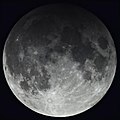A total lunar eclipse occurred at the Moon's descending node of orbit on Friday, March 14, 2025,[1] with an umbral magnitude of 1.1804. A lunar eclipse occurs when the Moon moves into the Earth's shadow, causing the Moon to be darkened. A total lunar eclipse occurs when the Moon's near side entirely passes into the Earth's umbral shadow. Unlike a total solar eclipse, which can only be viewed from a relatively small area of the world, a lunar eclipse may be viewed from anywhere on the night side of Earth. A total lunar eclipse can last up to nearly two hours, while a total solar eclipse lasts only a few minutes at any given place, because the Moon's shadow is smaller. Occurring about 3.3 days before apogee (on March 17, 2025, at 12:35 UTC), the Moon's apparent diameter was smaller.[2]
This lunar eclipse was the first of an almost tetrad, with the others being on September 8, 2025 (total); March 3, 2026 (total); and August 28, 2026 (partial).
This eclipse was seen from the surface of the Moon by Firefly Aerospace's Blue Ghost Mission 1 lander, which captured images of the ring of light around the Earth as the Sun passed behind it and the red glow on the Moon's surface.[3][4]
Visibility
The eclipse was completely visible over North America and South America, seen rising over Australia and northeast Asia and setting over Africa and Europe.[5]
 Simulated view of earth from moon |
 From moon, with IR clouds[6] |

|
Gallery
-
Shortly after totality, from Halifax, 07:35 UTC
-
Totality from Miamisburg, Ohio
-
Mid-eclipse, Minneapolis, 7:18 UTC
-
Partial-post-total eclipse, Minneapolis, 8:13 UTC
-
Before, during, and after eclipse from Indiana
-
Total lunar eclipse of 2025-03-14, as seen from North Vancouver, BC, Canada
Eclipse details
Shown below is a table displaying details about this particular lunar eclipse. It describes various parameters pertaining to this eclipse.[7]
| Parameter | Value |
|---|---|
| Penumbral Magnitude | 2.26146 |
| Umbral Magnitude | 1.18038 |
| Gamma | 0.34846 |
| Sun Right Ascension | 23h37m46.0s |
| Sun Declination | -02°24'16.8" |
| Sun Semi-Diameter | 16'05.2" |
| Sun Equatorial Horizontal Parallax | 08.8" |
| Moon Right Ascension | 11h38m23.0s |
| Moon Declination | +02°40'54.6" |
| Moon Semi-Diameter | 14'52.8" |
| Moon Equatorial Horizontal Parallax | 0°54'36.8" |
| ΔT | 71.7 s |
Eclipse season
This eclipse is part of an eclipse season, a period, roughly every six months, when eclipses occur. Only two (or occasionally three) eclipse seasons occur each year, and each season lasts about 35 days and repeats just short of six months (173 days) later; thus two full eclipse seasons always occur each year. Either two or three eclipses happen each eclipse season. In the sequence below, each eclipse is separated by 14 days.
| March 14 Descending node (full moon) |
March 29 Ascending node (new moon) |
|---|---|
 |

|
| Total lunar eclipse Lunar Saros 123 |
Partial solar eclipse Solar Saros 149 |
See also
References
- ^ "March 13–14, 2025 Total Lunar Eclipse (Blood Moon)". timeanddate. Archived from the original on 22 January 2025. Retrieved 18 November 2024.
- ^ "Moon Distances for London, United Kingdom, England". timeanddate. Retrieved 18 November 2024.
- ^ "Blue Ghost Mission 1: Live Updates".
- ^ "Firefly's Dazzling Images of Earth Eclipsing the Sun".
- ^ "Total Lunar Eclipse of 2025 Mar 14" (PDF). NASA. Archived (PDF) from the original on 4 December 2024. Retrieved 18 November 2024.
- ^ http://www.ssec.wisc.edu/data/comp/ir/2025073M0600.gif
- ^ "Total Lunar Eclipse of 2025 Mar 14". EclipseWise.com. Retrieved 18 November 2024.
External links
- Saros cycle 123
- 2025 Mar 14 chart: Eclipse Predictions by Fred Espenak, NASA/GSFC


















You must be logged in to post a comment.